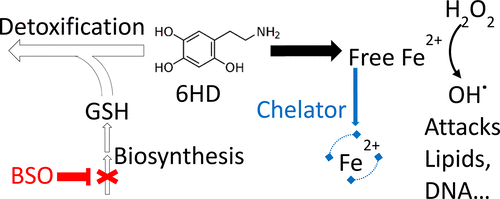当前位置:
X-MOL 学术
›
Chem. Res. Toxicol.
›
论文详情
Our official English website, www.x-mol.net, welcomes your feedback! (Note: you will need to create a separate account there.)
The Toxmatrix: Chemo-Genomic Profiling Identifies Interactions That Reveal Mechanisms of Toxicity
Chemical Research in Toxicology ( IF 4.1 ) Pub Date : 2017-12-04 00:00:00 , DOI: 10.1021/acs.chemrestox.7b00290 Zhi-Bin Tong 1 , Ruili Huang 1 , Yuhong Wang 1 , Carleen A. Klumpp-Thomas 1 , John C. Braisted 1 , Zina Itkin 1 , Paul Shinn 1 , Menghang Xia 1 , Anton Simeonov 1 , David L. Gerhold 1
Chemical Research in Toxicology ( IF 4.1 ) Pub Date : 2017-12-04 00:00:00 , DOI: 10.1021/acs.chemrestox.7b00290 Zhi-Bin Tong 1 , Ruili Huang 1 , Yuhong Wang 1 , Carleen A. Klumpp-Thomas 1 , John C. Braisted 1 , Zina Itkin 1 , Paul Shinn 1 , Menghang Xia 1 , Anton Simeonov 1 , David L. Gerhold 1
Affiliation

|
A chemical genomics “Toxmatrix” method was developed to elucidate mechanisms of cytotoxicity using neuronal models. Quantitative high-throughput screening (qHTS) was applied to systematically screen each toxicant against a panel of 70 modulators, drugs or chemicals that act on a known target, to identify interactions that either protect or sensitize cells to each toxicant. Thirty-two toxicants were tested at 10 concentrations for cytotoxicity to SH-SY5Y human neuroblastoma cells, with results fitted to the Hill equation to determine an IC50 for each toxicant. Thirty-three toxicant:modulator interactions were identified in SH-SY5Y cells for 14 toxicants, as modulators that shifted toxicant IC50 values lower or higher. The target of each modulator that sensitizes cells or protects cells from a toxicant suggests a mode of toxicant action or cellular adaptation. In secondary screening, we tested modulator-toxicant pairs identified from the SH-SY5Y primary screening for interactions in three differentiated neuronal human cell lines: dSH-SY5Y, conditionally immortalized dopaminergic neurons (LUHMES), and neural stem cells. Twenty toxicant-modulator pairs showed pronounced interactions in one or several differentiated cell models. Additional testing confirmed that several modulators acted through their primary targets. For example, several chelators protected differentiated LUHMES neurons from four toxicants by chelation of divalent cations and buthionine sulphoximine sensitized cells to 6-hydroxydopamine and 4-(methylamino)phenol hemisulfate by blocking glutathione synthesis. Such modulators that interact with multiple neurotoxicants suggest these may be vulnerable toxicity pathways in neurons. Thus, the Toxmatrix method is a systematic high-throughput approach that can identify mechanisms of toxicity and cellular adaptation.
中文翻译:

毒物基质:化学基因组分析可识别揭示毒性机制的相互作用
开发了化学基因组学“ Toxmatrix”方法,以使用神经元模型阐明细胞毒性的机制。定量高通量筛选(qHTS)用于系统筛选每种有毒物质,以对抗作用于已知靶标的70种调节剂,药物或化学物质,以鉴定保护或使细胞对每种有毒物质敏感的相互作用。测试了10种浓度的32种有毒物质对SH-SY5Y人成神经细胞瘤细胞的细胞毒性,并将结果拟合到Hill方程中,以确定每种有毒物质的IC 50。在SH-SY5Y细胞中鉴定出33种毒物:调节剂之间的相互作用为14种毒物,它们是改变毒物IC 50的调节剂值较低或较高。使细胞敏感或保护细胞免受毒物侵害的每种调节剂的靶标提示了毒物作用或细胞适应的模式。在二次筛选中,我们测试了从SH-SY5Y初次筛选中识别出的调节剂-毒物对在三种分化的神经元人类细胞系中的相互作用:dSH-SY5Y,有条件永生的多巴胺能神经元(LUHMES)和神经干细胞。在一个或几个分化的细胞模型中,二十对毒物-调节剂对表现出明显的相互作用。进一步的测试证实,有几个调制器通过其主要目标起作用。例如,几种螯合剂通过二价阳离子和丁硫氨酸磺胺嘧啶敏化的细胞与6-羟基多巴胺和4-(甲基氨基)苯酚半硫酸盐的螯合来阻止谷胱甘肽的合成,从而使分化的LUHMES神经元免受四种毒物的侵害。与多种神经毒物相互作用的此类调节剂表明,它们可能是神经元中易受伤害的毒性途径。因此,Toxmatrix方法是一种系统的高通量方法,可以确定毒性和细胞适应性机制。
更新日期:2017-12-04
中文翻译:

毒物基质:化学基因组分析可识别揭示毒性机制的相互作用
开发了化学基因组学“ Toxmatrix”方法,以使用神经元模型阐明细胞毒性的机制。定量高通量筛选(qHTS)用于系统筛选每种有毒物质,以对抗作用于已知靶标的70种调节剂,药物或化学物质,以鉴定保护或使细胞对每种有毒物质敏感的相互作用。测试了10种浓度的32种有毒物质对SH-SY5Y人成神经细胞瘤细胞的细胞毒性,并将结果拟合到Hill方程中,以确定每种有毒物质的IC 50。在SH-SY5Y细胞中鉴定出33种毒物:调节剂之间的相互作用为14种毒物,它们是改变毒物IC 50的调节剂值较低或较高。使细胞敏感或保护细胞免受毒物侵害的每种调节剂的靶标提示了毒物作用或细胞适应的模式。在二次筛选中,我们测试了从SH-SY5Y初次筛选中识别出的调节剂-毒物对在三种分化的神经元人类细胞系中的相互作用:dSH-SY5Y,有条件永生的多巴胺能神经元(LUHMES)和神经干细胞。在一个或几个分化的细胞模型中,二十对毒物-调节剂对表现出明显的相互作用。进一步的测试证实,有几个调制器通过其主要目标起作用。例如,几种螯合剂通过二价阳离子和丁硫氨酸磺胺嘧啶敏化的细胞与6-羟基多巴胺和4-(甲基氨基)苯酚半硫酸盐的螯合来阻止谷胱甘肽的合成,从而使分化的LUHMES神经元免受四种毒物的侵害。与多种神经毒物相互作用的此类调节剂表明,它们可能是神经元中易受伤害的毒性途径。因此,Toxmatrix方法是一种系统的高通量方法,可以确定毒性和细胞适应性机制。



























 京公网安备 11010802027423号
京公网安备 11010802027423号